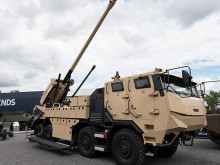The strategic environment is changing – are we ready?
The current strategic developments related to the deployment of new US missiles in Germany may have a significant impact on European security and defence. European states should react very quickly to this, particularly in the area of air and missile defence.
The US Government, in concert with the German Government, has recently announced that the latest US missiles will be deployed in Germany over the coming years as part of the build-up and deployment of the so-called Multi-Domain Task Force. This will take place from 2026 onwards and will initially be short-term intermittent deployments of the Task Force. Specifically, according to the White House statement, the deployment of ground-launched Tomahawk missiles, SM-6 missiles originally designed to shoot down ballistic missiles, and new, as yet unknown hypersonic missiles are under consideration.
_launches_RIM-174_June_2014.jpg)
The move is a continuation of the rivalry between US and Russia after the United states withdrew in 2019 from the original Intermediate- and Short-Range Missile Elimination Treaty signed in 1987. This treaty mandated both states (the US and the Soviet Union) to eliminate ground-launched missiles with a range between 310 and 3,500 miles (500 and 5,500 km). The United States withdrew on the basis of claims that Russia had consistently violated the treaty by developing and testing missiles with a range greater than 310 miles (500 km). However, the question is whether, in the context of competition with China, the real reason for the US was not rather the development of this type of missile in the aforementioned Asian country, which is not a signatory to a number of arms limitation treaties, giving it a free hand in the current strategic competition with the US.
For now, it is unclear how Russia will react to the deployment of US missiles on German territory. According to Russian President Vladimir Putin, Russia may respond by deploying similar systems on its territory. Russian Deputy Foreign Minister Sergei Ryabkov also mentioned the possibility of deploying additional nuclear weapons. It is likely that this statement was directed at tactical nuclear weapons. There are also reports on social media about the possibility of completing the development of the RS-26 Rubezh intercontinental missile project, which has been suspended in the past in favour of other projects, in particular hypersonic systems. The Rubezh project appears to be based on the RS-24 Jars intercontinental ballistic missile, with the latest information indicating that it has been tested at ranges between the aforementioned 310 and 3,500 miles limit.
Russia may therefore respond by deploying ballistic or cruise missiles with a range that could threaten most European capitals. It may also deploy additional nuclear weapons on Belarusian territory or it may involve more frequent patrols of Russian naval assets in the Atlantic Ocean.
In the context of the experience with Russian ballistic and cruise missiles and their deployment tactics, Europe must be wary. Although, practically since the beginning of the war in Ukraine, there have been calls in the public domain from time to time for a significant and very rapid strengthening of air and missile defence (AMD) capabilities and capacities, the development of these capabilities across Europe has been slow, not least because of the need to supply AMD assets to Ukraine. On the other hand, despite many unsubstantiated claims of a shortage of ballistic missiles or cruise missiles, the Russian military has managed to resume production and continues to use these missiles against a wide range of targets across Ukraine, placing high demands on the supply of air defence/air defence assets, including ammunition for these assets, to Ukraine.
It is the extensive deployment of Russian missiles together with the lack of air defence resources in the context of a change in the strategic environment in the form of the deployment of US and then Russian missiles that may be a rather unpleasant combination for European defence capabilities. Although, for example, the first components of the proven Israeli Spyder air defence systems have been delivered to the Czech Republic in recent weeks and the Czech Army will also receive new I-Derby Long Range missiles, these systems will not be operationally deployable in our army until 2028. Overall, then, the question is how and where the air defence capabilities of the Czech Armed Forces and other European states will develop in the coming years. In any case, it is clear that European armies, after long years of hardship, are gradually starting to re-launch much-needed modernisation projects related to air defence.
The strategic environment is changing at a fairly significant pace, to which European states should react very quickly, and it is in light of recent events that the strengthening of AMD assets should be one of the highest priorities, as these assets can, as we are seeing in Ukraine, make the difference in saving many lives. In the case of the Czech Republic, which in a hypothetical conflict with Russia will be an important logistics center, the role of the air and missile defence assets will be enhanced precisely because of the need to protect these centers and routes as much as possible.
























